6.11 The Main Yield Farming Techniques
Stop overpaying - start transferring money with Ogvio. Sign up, invite friends & grab Rewards now! 🎁
In this section, I will tell you what is yield farming in the field of crypto!
Yield farming has quickly become one of the more-popular methods of how people earn a passive income with their crypto. The concept itself is still a mystery to many, however - getting into yield farming can seem intimidating and confusing! That’s why I’ll try to strip the topic of any and all confusion, and tell you everything you need to know about yield farming.
In this section, we’re analyzing yield farming. I’ll tell you what yield farming is, how it works, and how you can start farming cryptocurrency yield, as well!
Let’s get to it!

Video Explainer
Video Explainer: The Main Yield Farming Techniques
Reading is not your thing? Watch the "The Main Yield Farming Techniques" video explainer
What is Yield Farming in Crypto? (Animated Explanation)
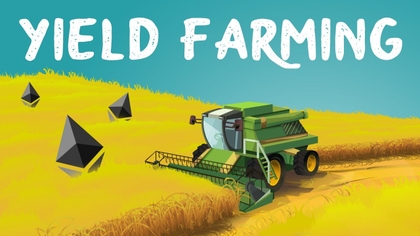

What is Yield Farming?
So, then - what is yield farming?
Well, the term consists of two words, so let’s break them down, shall we?
“Yield” refers to passive rewards that you’d receive for participating in some sort of a process. The rewards are passive, since you don’t need to actively participate in said processes, all the time.
In this context, “farming” simply means “continuous acquisition”. So, “yield farming” is simply a method of receiving passive profits (in the form of some asset) in a recurring manner. In principle, that’s pretty simple!
When it comes to crypto, yield farming isn’t all that different. You invest some cryptocurrency into a project, and then start receiving passive periodic gains - in other words, it’s a way to make a passive income!
Well, “invest” isn’t even necessarily the right term to use here, really. Rather, you would “lock” your crypto for some period of time. Allow me to illustrate with an example.

Imagine that you have a bag of 10 candies. One day, your friend comes up to you, and makes you an offer - if you give him the bag for a week, he’ll bring you back 12 candies.
Now, your friend WILL use the candies in your bag, in order to trade them with other people. However, by the end of the week, no matter what happens, you will still get 12 candies back.
Do you really care that your friend will use the candies throughout the week? Does that matter at all? Not really - all that matters is that you’ll get all of your candies back, and more!
This is, essentially, how yield farming works in crypto, too. Naturally, though, there are different types of yield farming that you could participate in! So, let’s check each of these types out, and try to figure out which is the most worthwhile, shall we?
Crypto Lending and Borrowing
The very first form of yield farming that you’ll likely come across is cryptocurrency lending and borrowing. This concept has become very popular throughout the last year or two!
There are multiple decentralized finance projects that allow crypto fans to both borrow cryptocurrencies, as well as lend them - platforms such as AAVE, which are a great example of this.
The most common way to participate in yield farming with such projects is to lend your crypto. Let’s say, you have 1 Bitcoin, and aren’t planning on selling or trading it anytime soon.
You would go to a platform such as AAVE, and lend that Bitcoin to someone else. Don’t worry, since the entire process is automated, and happens via special pools - there are minimal risks involved. If you’re not familiar with liquidity pools, though, I highly encourage you to read the section on the topic, in order to get a better understanding of the concept.
Now, depending on a few different factors, you could expect to receive an APR (Annual Percentage Rate) of up to and over 34%. In other words, in a year, you would end up with 0,34 BTC more - that’s a huge number!
To put it into context, with traditional banking institutions, your APR won’t really go over 1%. Well, you can probably see why crypto yield farming is as hot of a topic as it is!
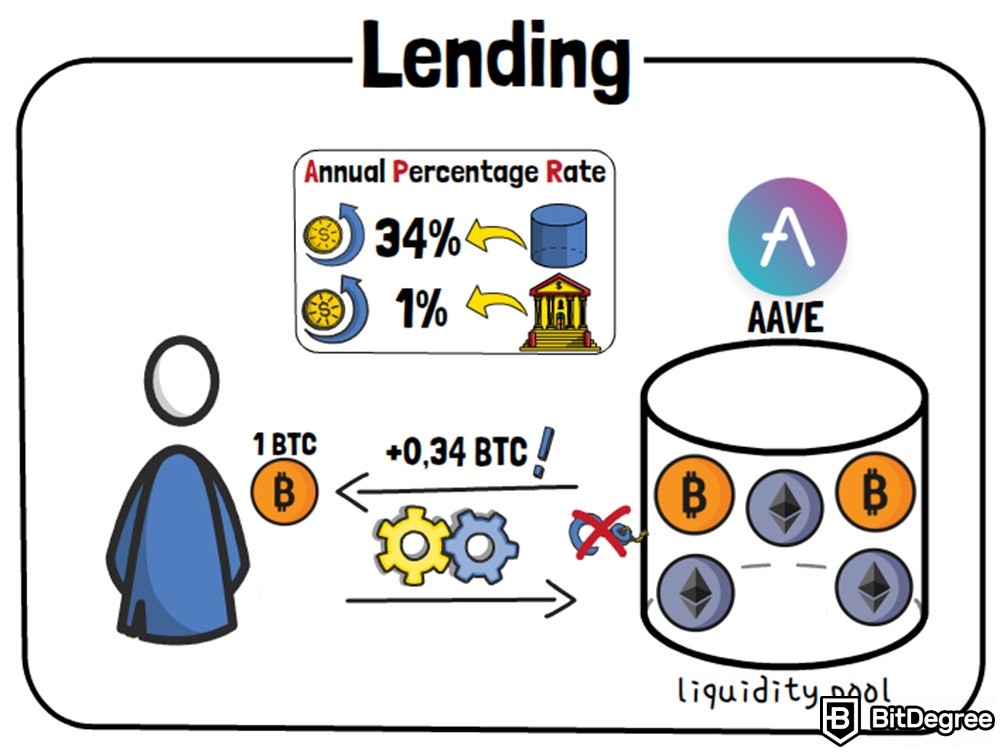
Another awesome feature of cryptocurrency lending is that, in most cases, you are able to withdraw your money at any point in time. So, if you DO end up needing that 1 Bitcoin, you can just take it out, with no strings attached.
Next up, borrowing. This one’s a bit tricky, I’ll admit, since it’s one of the more-unique forms of yield farming.
Imagine that you have a very old and valuable painting. You love that painting, spent a lot of time admiring it, and thus, don’t want to sell it! However, you’re in a bit of a pickle - you really need some money.
What you could do is borrow money, while placing your painting as collateral for the loan. Once you pay the loan (+interest) back, you will get your painting back, too. Now, since the painting is so old and valuable, its price on the market will increase during that period of the loan.
This is the general view of how yield farming works when you borrow cryptocurrencies. If you believe that Bitcoin is an awesome crypto, and it will rise in price, you could use it as collateral for your loan - then, you would have some money to work with, while also having BTC locked in as collateral, with the hopes that, once you repay your loan, that Bitcoin will be worth more than when you initially had it!
Now, there is one more awesome method of how you could participate in yield farming while borrowing and lending your cryptocurrencies. However, it’s a bit more complex, so we’ll leave it for the end of the section, as a bonus - make sure to read it till the end!
Providing Liquidity
Moving on, the second big form of yield farming is becoming a liquidity provider. It sounds fancy, but the core idea behind this is very simple - in order to understand it as best as possible, however, you should really go and read the section on liquidity pools that I’ve mentioned earlier!
Liquidity providers are people that provide their money to decentralized cryptocurrency exchanges, and receive passive returns for doing so. Let’s say that you have a $1000 laying around, and want to make it “work for you”, so to speak. Well, to start off, you would first convert that money to two cryptocurrencies - let’s say, Ethereum and AAVE.
Then, you would take your ETH and AAVE, and provide it to a decentralized exchange, such as Uniswap. People would then use your Ethereum and AAVE in order to swap from one cryptocurrency to another. Each of these swaps have fees!
Now, the fees are collected by Uniswap, and distributed to the liquidity providers as payment for their liquidity. A very simple, yet super-effective model!
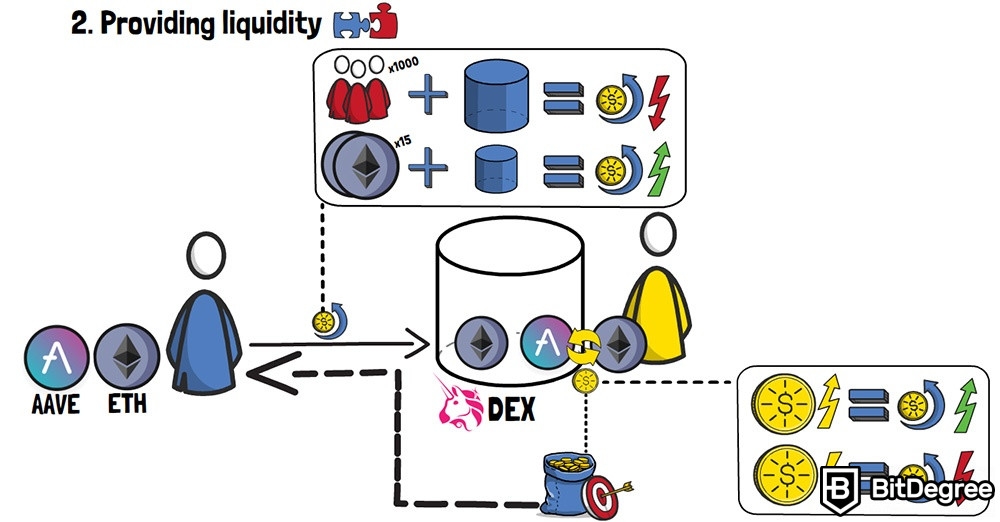
Your actual passive gains will depend on a few different factors. First of all, the amount that you provide as liquidity, and how many other liquidity providers are in the same pool. If the ETH-AAVE pool is huge, and there are thousands of others providing liquidity, you’ll probably get a smaller return!
However, if you provide the pool with a hefty sum of tokens, your returns will be much bigger, as well.
Another thing to look out for are the fees that the decentralized exchange imposes. Depending on these fees, your reward will vary, as well! To this day, however, Uniswap remains the most popular decentralized exchange when it comes to providing liquidity and earning passive interest.
Staking
Continuing on with the section, the third method of how you can participate in yield farming is one that’s familiar to many cryptocurrency enthusiasts - staking.
At first glance, staking can appear much the same as providing liquidity - you have some crypto coins or tokens, and provide them to a specific platform, in order to earn passive returns. I have to admit, going into the topic in-depth, things aren’t that simple - do check out the section on staking, as well as the differences between coins and tokens if you’d like to learn more.
For the sake of keeping this section about yield farming, though, let’s just say that staking is when you lock up your tokens in the network, in order for them to confirm other people’s transactions. Only specific coins can be staked - those that are built on the Proof-of-Stake consensus model!
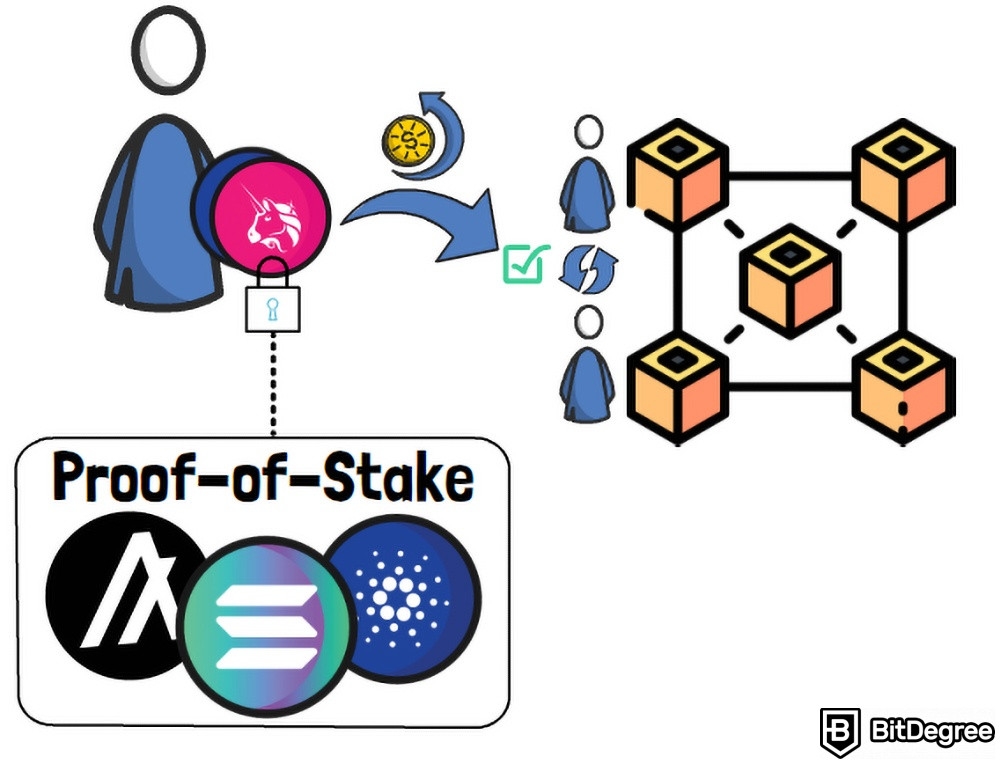
The simplest example of staking would be that of the Cardano project, and its native coin called ADA. You can purchase ADA on most top-rated cryptocurrency exchanges on the market, such as Binance or Coinbase. After you have your ADA coins, you would then need to find a staking pool - the simplest way to do this is to transfer your ADA into the Yoroi wallet - it’s a browser extension-based wallet, and is the most popular place where people store and keep their ADA coins. Also, Yoroi has multiple pools available to be accessed from within the wallet!
All that you need to do is choose the pool that you want, and delegate your ADA coins into it. As time goes on, your coins will start earning passive returns for you!
Admittedly, this is a topic that deserves a separate section, of its own.

Another way how you can stake coins, and thus, farm yield, is on cryptocurrency exchanges themselves. Some of the most popular exchange platforms are beginning to offer their users staking functionality - you could purchase coins, and then simply stake them from within your exchange-based cryptocurrency wallet - there’s usually just one button to press, and that’s it!
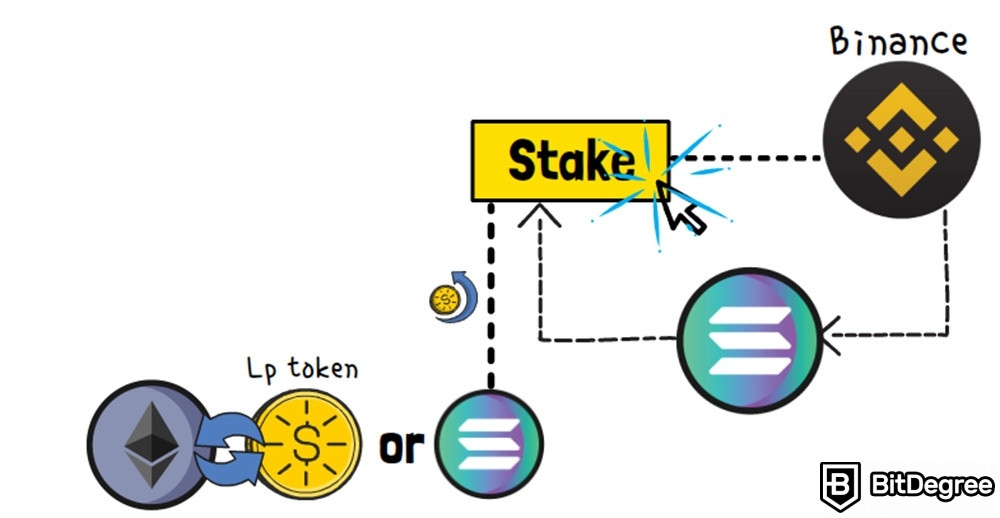
In most cases, your yield rewards will be the same tokens that you stake, or the so-called “LP tokens”, otherwise known as liquidity provider tokens. You will then be able to trade these LP tokens to another cryptocurrency, such as Ethereum.
Redistribution Fees
The last big method of how you can participate in yield farming is by holding cryptocurrencies that have redistribution fees.
Sounds fancy? Well, it’s super-simple, really!
Some cryptocurrencies have what are called “redistribution fees”. This means that, whenever you trade this crypto, a part of the fees that you pay for the trade will be distributed to other holders of this cryptocurrency.
Probably the best-known example of this would be Safemoon. This is a very popular cryptocurrency that has redistribution fees, as well as token-burning mechanics.
Token burning sounds pretty fancy, but it really is simple. As you transact with a cryptocurrency, you pay certain fees for your transactions, in the form of those same tokens - so, let’s say, if you want to send 10 Safemoon to your friend, that will cost you 1 Safemoon token, as a transaction fee.
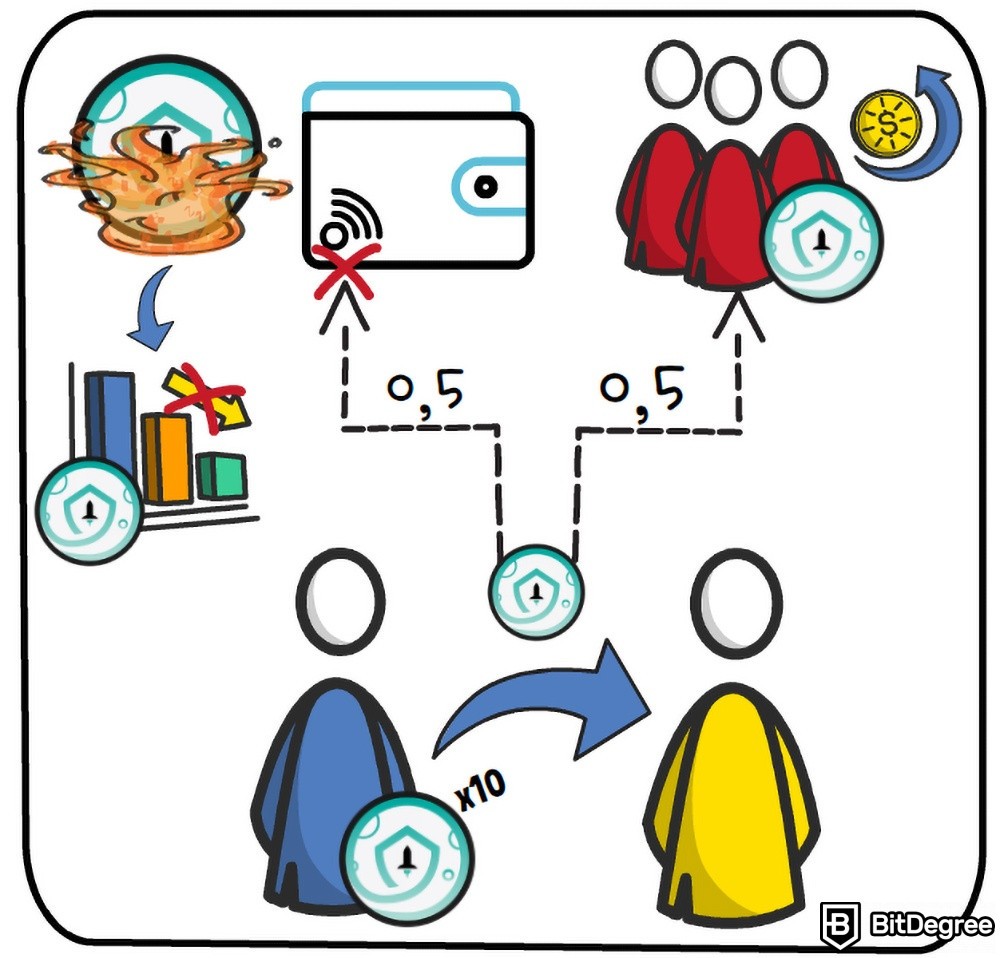
Some of those fees will be redistributed to token holders - say, they would share 0,5 of a Safemoon token. The other 0,5 Safemoon would be sent to an inactive, inaccessible wallet. This is what is called “token burning” - tokens in this wallet would be lost forever. This way, the token battles inflation, and still rewards holders!
Now, obviously, there are various technicalities to be aware of, when it comes to this type of yield farming. The token may sway in price heavily, and you would need to have A LOT of tokens in order to receive any notable yield gains.
Leveraged Lending
So, with the four big, main yield farming methods out of the way, I’d also like to tell you about a bonus method. It’s called “leveraged lending” - I left it as a bonus because it’s a bit trickier than the other yield farming tactics we’ve discussed in this section.
Imagine that you have $100 in ETH. You decide to lend the ETH, and borrow some DOGE coins, by putting your ETH up as collateral. Since your collateral will always need to be bigger than your loan, you receive $70 worth of Dogecoin in return.
Now, what you would do is go to a cryptocurrency exchange, and trade in your Dogecoins for Ethereum. You now have ETH again! So, you take it back to the lending platform, put in your new ETH coins, and borrow some more Dogecoin - and repeat the process!
Since your collateral will always be higher than your loan, this does have an endpoint. However, by the end, you’ll have much more ETH in the lending platform than you did at the beginning.
This isn’t a very simple process to set up, since it requires knowledge of APRs, different lending and borrowing platforms, and great timing. Also, the prices of cryptocurrencies these days are rather volatile, and you might end up liquidating your positions, if the price of ETH drops too much. However, with a bit of practice, this can be a pretty interesting yield farming strategy!
So, to conclude the section, I’d like to say that, when it comes to yield farming, there are multiple methods that you could employ, with varying degrees of risk and reward. In short, though, you should focus on the top-rated projects, and cryptocurrencies that have historically shown signs of resistance against large price swings and general market volatility.










